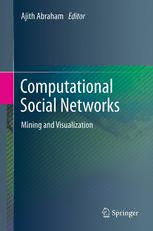Table Of ContentComputational Social Networks
Ajith Abraham
Editor
Computational Social
Networks
Mining and Visualization
123
Editor
AjithAbraham
MachineIntelligenceResearchLabs
(MIRLabs)
ScientificNetworkforInnovation
andResearchExcellence
Auburn,Washington,USA
ISBN978-1-4471-4053-5 ISBN978-1-4471-4054-2(eBook)
DOI10.1007/978-1-4471-4054-2
SpringerLondonHeidelbergNewYorkDordrecht
LibraryofCongressControlNumber:2012944255
©Springer-VerlagLondon2012
Thisworkissubjecttocopyright.AllrightsarereservedbythePublisher,whetherthewholeorpartof
thematerialisconcerned,specificallytherightsoftranslation,reprinting,reuseofillustrations,recitation,
broadcasting,reproductiononmicrofilmsorinanyotherphysicalway,andtransmissionorinformation
storageandretrieval,electronicadaptation,computersoftware,orbysimilarordissimilarmethodology
nowknownorhereafterdeveloped.Exemptedfromthislegalreservationarebriefexcerptsinconnection
with reviews or scholarly analysis or material supplied specifically for the purpose of being entered
and executed on a computer system, for exclusive use by the purchaser of the work. Duplication of
this publication or parts thereof is permitted only under the provisions of the Copyright Law of the
Publisher’slocation,initscurrentversion,andpermissionforusemustalwaysbeobtainedfromSpringer.
PermissionsforusemaybeobtainedthroughRightsLinkattheCopyrightClearanceCenter.Violations
areliabletoprosecutionundertherespectiveCopyrightLaw.
Theuseofgeneraldescriptivenames,registerednames,trademarks,servicemarks,etc.inthispublication
doesnotimply,evenintheabsenceofaspecificstatement,thatsuchnamesareexemptfromtherelevant
protectivelawsandregulationsandthereforefreeforgeneraluse.
While the advice and information in this book are believed to be true and accurate at the date of
publication,neithertheauthorsnortheeditorsnorthepublishercanacceptanylegalresponsibilityfor
anyerrorsoromissionsthatmaybemade.Thepublishermakesnowarranty,expressorimplied,with
respecttothematerialcontainedherein.
Printedonacid-freepaper
SpringerispartofSpringerScience+BusinessMedia(www.springer.com)
Preface
ComputationalSocialNetworkisanewemergingfieldthathasoverlappingregions
fromMathematics,Psychology,ComputerSciences, Sociology,andManagement.
Emails,blogs,instantmessages,socialnetworkservices,wikis,socialbookmarking,
andotherinstancesofwhatisoftencalledsocialsoftwareillustrateideasfromsocial
computing.
Social network analysis is the study of relationships among social entities.
Very often, all the necessary information is distributed over a number of Web
sites and servers, which brings several research challenges from a data mining
perspective.Real-worldsocialnetworksareverydynamicandconstantlyevolving.
Sometimes, it is much harder for us to comprehend how users in a network are
connected and how influential some connections are. Visualization helps us with
a better understanding of how networks function. This volume is a collection
of chapters authored by world-class experts illustrating the concept of social
networksfromacomputationalpointofview,withafocusonknowledgediscovery
(mining) and visualization of complex networks, and open avenues for further
research. The authorspresent some of the latest advancesof computationalsocial
networks and illustrate how organizations can gain competitive advantages by a
better understanding of real-world complex social networks. Experience reports,
survey articles, and intelligence techniques and theories with specific networks
technology problems are depicted. We hope that this book will be useful for
researchers, scholars, postgraduate students, and developers who are interested
in social networks research and related issues. In particular, the book will be a
valuablecompanionandcomprehensivereferenceforbothpostgraduateandsenior
undergraduatestudentswhoaretakingacourseinComputationalSocialNetworks.
The book contains fourteen Chapters, which are divided into two Parts and all
chaptersareself-containedtoprovidegreatestreadingflexibility.
Part I comprises of nine chapters (including an introductory chapter) and
deals with the modeling aspects and various computational tools used for better
understandingandknowledgediscoveryincomplexnetworks.
In Chap. 1, Ghali et al. introduce the concept of mining and visualization in
socialnetworks.Thischapterbridgesthegapbycombiningsocialnetworkanalysis
v
vi Preface
methods and informationvisualization technologyto help a user visually identify
theoccurrenceofapossiblerelationshipamongthemembersinasocialnetwork.
Pandaetal.inChap.2introduceclusteringanalysistoanalyzesocialnetworks.
Theauthors’approachisintendedtoaddresstheusersofsocialnetwork,whichwill
notonlyhelpanorganizationtounderstandtheirexternalandinternalassociations
butisalso highlynecessaryforthe enhancementof collaboration,innovation,and
disseminationofknowledge.
In Chap. 3, Bojic et al. provide a useful insight into the differences between
the human social networks based on human-to-human (H2H) interactions and
the machine social networks based on machine-to-machine interactions (M2M).
The authors illustrate how to analyze social networks by connecting ethological
approachestosocialbehaviorinanimalsandM2Minteractions.
Mirkovic et al. in Chap. 4 propose approaches to understand georeferenced
community-contributedmultimediadatathatenableuserstoanswermanyquestions
regardinghumanbehavior,sincetheyareabletodiscovernewtrendsinwho(user),
what(content),when(time),andwhere(place).
InChap.5,Liuetal.focusontheproblemofcorrelationmininginnewsretrieval.
The authors present a framework of multimodal multicorrelation news retrieval,
which integrates news event correlation, news entity correlation, and event-entity
correlationsimultaneouslybyexploringbothtextandimageinformation.Thepro-
posedframeworkenablesamorevividandinformativenewsbrowsingbyproviding
twoviewsofresultpresentation,namelyaquery-orientedmulticorrelationmapand
arankinglistofnewsitemswithnecessarydescriptionsincludingnewsimage,title,
centralentities,andrelevantevents.
Liao et al. in Chap. 6 investigate how micromessaging technologies such as
Twitter messages can be harnessed to obtain valuable information. The authors
providesomeofthepotentialapplicationsofthemicromessagingservicesandthen
discuss some insight into different challenges faced by data mining applications.
Finally,microbloggingservicesareillustratedbythreedifferentcasestudies.
InChap.7,LiuandYangproposeatime-sensitivenetworkbyusingtimestamp
to enhance edge representation, and then provide a methodology based on the
frameworkofbusinessintelligenceplatformtosupportdynamicnetworkmodeling,
analysis, and data mining. A proposed framework is illustrated using a nice case
study.
BenAbdesslemetal.inChap.8provideadetailedreviewaboutsocialnetwork
data collection and user behavior. The authors highlight the shortcomings in the
past research works, and introduce a novel methodology based on the experience
samplingmethod.
InChap.9,Guidietal.focusonTwittersocialnetworkfeaturesandwellknown,
user’s behavior. The authors used the contents that previously Senator and then
PresidentBarack ObamahassharedinTwitter duringa courseofthreeyears, and
applied text-analysis. The study reveals that the discovered data clusters could be
interpretedasamirrorofhispoliticalstrategy.
Preface vii
PartIIdealswithusageofsocialnetworktoolsandframeworksforvisualization
andconsistsoffivechapters.
Reinhardt et al. in Chap. 10 propagate that Artifact-Actor-Networks (AANs)
serve wellfor modeling,storing,and miningthe social interactionsarounddigital
learningresourcesoriginatingfromvariouslearningservices.Theauthorsillustrate
theconceptbytheanalysisofsixnetworks.
In Chap. 11, Hung et al. present hypergraph-based clustering method, which
utilizes 3D user usage and traversal pattern information to capture user access
patterns.Theauthorsintroduceastoragesolutioncalledobject-orientedhypergraph-
basedclusteringapproach,whichemployshiddenhintingamongobjectsinvirtual
environments.
Catanese et al. in Chap. 12 analyze Facebook by acquiring the necessary
information directly from the front-end of the Web site, in order to reconstruct
a subgraph representing anonymous interconnections among a significant subset
of users. The authors describe a privacy-compliant crawler for Facebook data
extraction and two different graph-mining techniques: breadth-first search and
rejection sampling to analyze the structural properties of samples consisting of
millionsofnodes.
Yu and Ramaswamy in Chap. 13 analyze the relationship between human–
computerinteractionandsocialnetworking.Aframeworkisoutlinedforrepresent-
ingandmeasuringonlinesocialnetworks,especiallythoseformedthroughWeb2.0
applicationsandisillustratedusingacasestudyperformedonWikipedia.
In the last chapter, Sulaiman et al. analyze Web cache server data using social
network analysis (SNA) and make a number of statistic measurements to reveal
the hidden information in a real-world E-learning environment. The log dataset
is displayed as a connected graph and is clustered based on the similarity of
characteristics,andtheanalysisrevealinterestingresults.
I am verymuch gratefulto the authorsof this volume and to the reviewersfor
their tremendousservice by critically reviewing the chapters. Most of the authors
of chapters included in this book also served as referees for chapters written by
otherauthors.Thanksgotoallthosewhoprovidedconstructiveandcomprehensive
reviews.IwouldliketothankWayneWheelerandSimonReesofSpringerVerlag,
London, for the editorial assistance and excellent cooperative collaboration to
produce this important scientific work. Finally, I hope that the reader will share
ourexcitementtopresentthisvolumeonsocialnetworksandwillfindituseful.
MachineIntelligenceResearchLabs(MIRLabs) Prof.(Dr.)AjithAbraham
ScientificNetworkforInnovationandResearch
Excellence(SNIRE)
P.O.Box2259,Auburn,WA98071,USA
http://www.mirlabs.org
Email:[email protected]
PersonalWWW:http://www.softcomputing.net
Contents
PartI Mining
1 SocialNetworksAnalysis:Tools,MeasuresandVisualization ........ 3
NeveenGhali,MrutyunjayaPanda,AboulEllaHassanien,
AjithAbraham,andVaclavSnasel
2 PerformanceEvaluationofSocialNetworkUsingData
MiningTechniques ......................................................... 25
MrutyunjayaPanda,AjithAbraham,SachidanandaDehuri,
andManasRanjanPatra
3 Bio-inspiredClusteringandDataDiffusioninMachine
SocialNetworks............................................................. 51
IvaBojic,TomislavLipic,andVedranPodobnik
4 Mining Geo-Referenced Community-Contributed
MultimediaData............................................................ 81
MilanMirkovic,DubravkoCulibrk,andVladimirCrnojevic
5 CorrelationMiningforWebNewsInformationRetrieval............. 103
JingLiu,ZechaoLi,andHanqingLu
6 MiningMicro-blogs:OpportunitiesandChallenges ................... 129
Yang Liao, Masud Moshtaghi, Bo Han, Shanika
Karunasekera,RamamohanaraoKotagiri,TimothyBaldwin,
AaronHarwood,andPhilippaPattison
7 Mining Buyer BehaviorPatternsBasedon Dynamic
Group-BuyingNetwork.................................................... 161
XiaoLiuandJianmeiYang
8 ReliableOnlineSocialNetworkDataCollection........................ 183
FehmiBenAbdesslem,IainParris,andTristanHenderson
ix
x Contents
9 KnowledgeMining fromthe TwitterSocialNetwork:
TheCaseofBarackObama ............................................... 211
MarcoGuidi,IgorRuiz-Agundez,
andIzaskunCanga-Sanchez
PartII Visualization
10 MiningandVisualizingResearchNetworksUsing
theArtefact-Actor-NetworkApproach................................... 233
WolfgangReinhardt,AdrianWilke,MatthiasMoi,
HendrikDrachsler,andPeterSloep
11 Intelligent-BasedVisualPatternClusteringforStorage
LayoutsinVirtualEnvironments......................................... 269
Shao-ShinHung, Chih-MingChiu, TsouTsunFu,
JungTzungChen,andJyh-JongTsay
12 ExtractionandAnalysisofFacebookFriendshipRelations........... 291
Salvatore Catanese, Pasquale De Meo, Emilio Ferrara,
GiacomoFiumara,andAlessandroProvetti
13 AnalysisofHuman-ComputerInteractionsandOnline
SocialNetworking:AFramework........................................ 325
LiguoYuandSriniRamaswamy
14 ImplementationofSocialNetworkAnalysisforWeb
CacheContentMiningVisualization..................................... 345
SarinaSulaiman, SitiMariyamShamsuddin,
andAjithAbraham
Index............................................................................... 377

